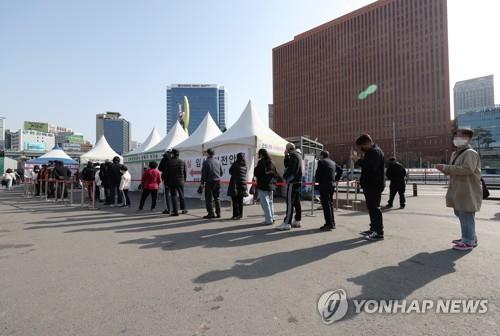- California Assembly OKs highest minimum wage in nation
- S. Korea unveils first graphic cigarette warnings
- US joins with South Korea, Japan in bid to deter North Korea
- LPGA golfer Chun In-gee finally back in action
- S. Korea won’t be top seed in final World Cup qualification round
- US men’s soccer misses 2nd straight Olympics
- US back on track in qualifying with 4-0 win over Guatemala
- High-intensity workout injuries spawn cottage industry
- CDC expands range of Zika mosquitoes into parts of Northeast
- Who knew? ‘The Walking Dead’ is helping families connect
New infections fall below 200,000 as peak of worst wave passes
South Korea’s new daily COVID-19 cases fell below 200,000 for the first time in 25 days Monday, as the omicron-driven virus peak appears to have passed amid growing concerns over the spread of the even more transmissible “stealth omicron” subvariant.
The country added 187,213 new coronavirus infections, including 25 cases from overseas, bringing the total caseload to 12,003,054, the Korea Disease Control and Prevention Agency (KDCA) said.
It is the first time since March 2 that the daily caseload dropped below 200,000. On March 2, the figure came to 198,803.



People stand in line to take coronavirus tests at a makeshift testing site in front of Seoul Station on March 27, 2022. South Korea reported 318,130 new virus cases on the day. (Yonhap)
Health Minister Kwon Deok-cheol said the virus wave reached the peak around last week and has shifted to a downward trend some 11 weeks after a drastic increase in infections.
More than 10 million cases out of the 12 million COVID-19 infections so far have been reported since last month, with the daily tally surging to as high as 621,197 on March 17 amid the raging omicron variant.
But the caseload has been on a constant slide since Wednesday. Monday’s tally is down from 318,130 reported the previous day, and the comparable figure for a week earlier is 209,000.
“But we cannot let down our guard, as the number of serious cases and deaths could spike further two to three weeks after the peak,” Kwon said during a meeting over the country’s response to the new coronavirus.
The country added 287 new COVID-19 deaths on Monday, up five from the previous day’s tally. The fatality rate stood at 0.13 percent.
The number of critically ill patients reached an all-time high of 1,273 on Monday, up 57 from the previous day, the KDCA said. The previous record of was 1,244 logged on March 16.
As of 6 p.m., the country had added 244,419 new COVID-19 cases, down 86,869 from the same time the previous day, according to health authorities and city governments.
Daily cases are counted until midnight and announced the following morning.
Serious cases rose to above 1,000 earlier this month and have since been above the level, though the KDCA expects the figure to stop short of surpassing 2,000, as the growth has slowed down recently.
Some 70 percent of the country’s hospital beds reserved for serious COVID-19 patients were occupied as of Monday, up 2.2 percentage points from the previous day, according to the KDCA.
Adding to the woes is the prevalence of the BA.2, the “stealth omicron” subvariant.
BA.2 became the dominant variant in South Korea by accounting for 56.3 percent of the total infections last week, up from 22.9 percent in the first week of this month, the health authorities said.
“As the stealth omicron has been spreading at a fast pace, the number of virus patients has moved up again in some European nations. We need to monitor the situation more closely before definitely saying if the pandemic is tracking downward,” Kwon said.
He also pointed to “hidden infections,” as there could be some people trying to shun a virus test despite symptoms.
As of Monday, 32.63 million people out of the total population, or 63.6 percent, had received booster shots. The number of fully vaccinated people came to 44.47 million, representing 86.7 percent, the KDCA said.
The government once again called on people, particularly those aged 60 or older, to get a booster shot, as the proportion of infections of the age group has risen recently to stay above 20 percent.
Elderly citizens also accounted for a majority of the country’s seriously ill patients and new deaths, according to the KDCA.
Last week, the government additionally bought Pfizer’s oral COVID-19 treatment pill, Paxlovid, for 200,000 patients, bringing the country’s total contracted amount of the treatment pills to enough for 962,000 people, the KDCA said.
Last week, the authorities also began administering MSD’s oral pill, Lagevrio, for patients with underlying illnesses or symptoms that forbid them from taking Paxlovid or other treatment pills.
The country bought a total of Lagevrio pills for 242,000 patients, and the first batch, enough for 20,000 people, has arrived so far, the KDCA said.
In a move to better support at-home treatment patients, the government vowed to have more smaller-scale local medical clinics provide face-to-face treatment to them.
The government has shifted away from rigorous contact tracing and treatment, and focused on dealing with seriously ill patients and ways to prevent deaths following the omicron-driven wave of the pandemic.
The government is expected to announce a decision around Friday on whether to further relax antivirus curbs, as the current restrictions, including the eight-person cap on private gatherings and the 11 p.m. business curfew, are supposed to expire Sunday.
The government has relaxed some social distancing rules in efforts to regain normalcy, and support small businesses and self-employed people hit hard by the pandemic.











